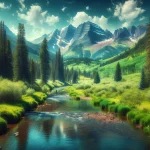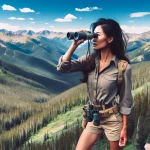Known for its miles of hiking and biking trails, excellent fishing spots, and abundant wildlife, Boulder Creek is a popular destination for nature lovers, outdoor enthusiasts, students, researchers, and anyone looking to immerse themselves in the great outdoors.
In This Article
This article explores the many attractions and activities that make Boulder Creek an appealing tourist destination. From its rich biodiversity and conservation efforts to its cultural events and local cuisine, Boulder Creek has something to offer for every type of traveler.
TL;DR
- Boulder Creek is a nature lover's paradise with hiking, fishing, kayaking, and other outdoor activities set against beautiful mountain scenery.
- The area has a vibrant local culture and cuisine using fresh, seasonal ingredients.
- Boulder Creek offers environmental education and research opportunities through ecological surveys, climate studies, and conservation efforts.
Destination Overview
Boulder Creek is a 31.4-mile-long creek running along the west edge of Boulder, Colorado. It’s fed by water from the Rocky Mountains. Boulder Creek is a popular recreational area for fishing, tubing, wading, and scenic trails.
Outdoor Activities
Boulder Creek’s main draw is the abundance of outdoor recreation set against beautiful mountain vistas. The 2.6-mile Boulder Canyon Trail connects the city of Boulder to the longer Boulder Creek Path, which offers over 7 miles of trail for walking, biking, and skating. Popular routes also include the trails in the Roosevelt National Forest just outside town.
In addition to hiking and biking, Boulder Creek offers excellent fishing spots in its namesake creek’s cold, rushing waters. Anglers can try catching brown, rainbow, and cutthroat trout along the creek. The area also has opportunities for kayaking and rafting on Boulder Creek, with some rapids available during high water flows in the spring.
For those looking for more leisurely water activities, there are designated swimming areas and spots for tubing during the warmer months. In the winter, outdoor enthusiasts can try snowshoeing, cross-country skiing, ice fishing, and more on the snow-covered trails and frozen creek.
Hiking Trails:
Boulder Creek Path, Roosevelt National Forest
Fishing Spots:
Boulder Creek – trout
Kayaking and Rafting:
Boulder Creek rapids
Wildlife and Nature
Another major highlight of Boulder Creek is the abundance and diversity of wildlife and nature visitors can experience. The area provides excellent birdwatching, especially along riparian habitats by Boulder Creek, where over 150 species of birds have been recorded. Some sightings include American dippers, belted kingfishers, warblers, flycatchers, and even the occasional bald eagle.
In addition to birds, visitors may spot mule deer, black bears, coyotes, red foxes, and more in the forests surrounding Boulder Creek. Wildflowers, diverse flora, and fauna thrive in this ecosystem and can be admired on leisurely nature walks. Some iconic high alpine species include columbines, larkspurs, paintbrush, and fireweed.
By getting to know this rich biodiversity and natural beauty through sightseeing, hiking, and recreation, visitors can gain inspiration and motivation to support crucial conservation efforts in the area through programs that protect habitats, restore degraded lands, and foster sustainable outdoor recreation.
Birdwatching:
150+ species, including warblers, kingfishers, flycatchers, bald eagles
Flora and Fauna:
Wildflowers, deer, bears, foxes
Conservation Efforts:
Habitat protection, land restoration
Water Sports and Recreation
As its namesake implies, Boulder Creek offers the perfect setting for water sports and recreational activities during spring and summer. The creek provides routes for fly fishing and even whitewater kayaking when water levels peak.
For more relaxed water recreation, popular activities include tubing and swimming along calm sections of the creek. Families with young children also enjoy wading in shallow pools and picnics along the creek. Many scenic parks offer picnic facilities, hiking trails, and natural areas perfect for passing a summer day.
Thanks to conservation efforts, Boulder Creek’s water quality is closely monitored and maintained at healthy levels to support native fish and aquatic species and provide safe recreation for visitors. Effective flood management strategies also help reduce erosion and property damage during periods of high runoff.
Fly Fishing:
Trout fishing on Boulder Creek
Tubing and Swimming:
Designated recreation areas
Water Quality and Flood Management:
Conservation efforts for recreation and safety
Environmental Education and Research
Boulder Creek also appeals to visitors interested in learning about local ecology and environmental systems. The area provides exceptional opportunities for outdoor education programs, student field trips, and even citizen science projects to engage people of all ages.
In addition to experiential learning, Boulder Creek has been the study site for various formal environmental research projects over recent decades, documenting details about its climate, water quality, plant communities, and more. Findings from these studies help inform conservation strategies for maintaining healthy natural systems that support wildlife habitats, recreation, and other human uses.
Visitors can learn about this research at the Boulder Creek Critical Zone Observatory. This National Science Foundation-funded project has compiled detailed measurements characterizing water flow paths, soil composition, vegetation, microbial communities, and other ecosystem components. These data provide insights into the effects of climate variability and disturbances like floods and fires on mountain watersheds.
Outdoor Education:
Experiential programs for all ages
Environmental Research:
Climate patterns, water quality, ecosystems
Scenic Views and Photography
Boulder Creek is a photographer’s paradise with its beautiful mountain scenery, diverse landscapes, and abundant wildlife. Some of the most iconic scenic views include overlooks along Boulder Creek with the Flatirons in the background, alpine meadows filled with wildflowers, fall colors lighting up the forests, and historic barns set against the mountains.
In addition to majestic scenery, visitors can also capture more intimate shots of native plants and wildlife. Popular subjects include colorful birds along the creek, deer in meadows at dawn, and macro flower photography. Local photography guides can provide insider knowledge on the best times and locations to spot photogenic wildlife.
Boulder Creek parks offer picnic facilities and short nature trails perfect for family photo sessions with mountain backdrops. Scenic bike paths allow cyclists to pause and capture landscapes along the creek and surrounding forest.
Scenic Views:
Creek overlooks, alpine meadows, mountain vistas
Photography:
Birds, deer, wildflowers, fall colors
Bike Paths:
Scenic cycling routes
Visitor Guide and Planning
To help visitors make the most of their time exploring Boulder Creek, local guides offer trip-planning resources, maps, recommendations for top attractions, and advise on the best times of year to visit based on seasonal activities and events.
In addition to detailed trail maps covering the extensive hiking and biking routes, resources provide information about camping options. Visitors can pitch a tent at one of several area campgrounds or stay at local hotels and vacation rentals in Boulder.
Since weather conditions vary considerably across seasons, guides offer packing checklists so visitors come prepared with the proper gear and clothing. For example, warm layers and waterproof boots are recommended for spring hikes when lingering snowmelt keeps trails wet. And ultraviolet protection is crucial during dry summer months at high elevations.
Trail Maps and Camping:
Trip planning and navigation resources
Best Times to Visit:
Seasonal highlights and recommendations
FAQ
What are the top things to do in Boulder Creek?
The top activities and attractions include hiking scenic trails, fishing along Boulder Creek, photographing mountain vistas, birdwatching, kayaking and tubing the creek, cycling the bike paths, attending cultural events, and sampling local cuisine.
When is the best time to visit Boulder Creek?
Spring and fall are excellent times with comfortable weather for hiking and sightseeing. Summer offers water recreation and festivals, and winter provides opportunities for snow sports.
Where are the best fishing spots along Boulder Creek?
Some top fishing access points include Eben G. Fine Park and other Boulder Creek parks along the creek stretching into Roosevelt National Forest.
What wildlife might I spot around Boulder Creek?
Keep an eye out for colorful birds like warblers and kingfishers along the creek, as well as larger mammals such as deer, foxes, coyotes, black bears, and even moose in the surrounding mountains.
Where can I access water recreation on Boulder Creek?
Areas like Eben G. Fine Park and Boulder Creek Park have designated tubing and swimming sections. Outfitters in town also offer whitewater rafting and kayaking along faster-moving sections.
How long is the Boulder Creek bike path?
The paved Boulder Creek Path stretches over 7.5 miles along the creek corridor connecting parks, trails, and Boulder Creek neighborhoods.






